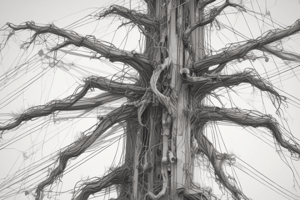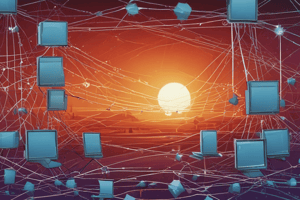Podcast
Questions and Answers
What is the primary criterion used by a switch to determine which port to select when there are multiple equal-cost paths to the root bridge?
What is the primary criterion used by a switch to determine which port to select when there are multiple equal-cost paths to the root bridge?
- Lowest sender port priority
- Lowest sender BID (correct)
- Lowest root port cost
- Lowest port ID
Which port state is employed by ports that are not designated ports or root ports?
Which port state is employed by ports that are not designated ports or root ports?
- Learning
- Listening
- Discarding (correct)
- Forwarding
In the context of STP, what does the Bridge Priority configuration influence?
In the context of STP, what does the Bridge Priority configuration influence?
- Electing the root bridge (correct)
- Choosing designated ports
- Setting the port state
- Determining the root port
What occurs during the root bridge election process in a spanning tree?
What occurs during the root bridge election process in a spanning tree?
What does PVST+ enhance in standard spanning tree protocols?
What does PVST+ enhance in standard spanning tree protocols?
Which timers are essential for STP convergence?
Which timers are essential for STP convergence?
What feature allows RSTP to provide a faster transition to the forwarding state compared to traditional STP?
What feature allows RSTP to provide a faster transition to the forwarding state compared to traditional STP?
When does a port enter the forwarding state within STP?
When does a port enter the forwarding state within STP?
What is the default Bridge ID (BID) value for a switch in a Spanning Tree Protocol (STP)?
What is the default Bridge ID (BID) value for a switch in a Spanning Tree Protocol (STP)?
How do switches determine which switch will become the root bridge when they have identical BIDs?
How do switches determine which switch will become the root bridge when they have identical BIDs?
What factor determines the internal root path cost in STP?
What factor determines the internal root path cost in STP?
What three components are combined to determine a Bridge ID (BID)?
What three components are combined to determine a Bridge ID (BID)?
What happens when multiple switches have the same configured priority of 32769?
What happens when multiple switches have the same configured priority of 32769?
How often does a switch send out BPDU frames after booting?
How often does a switch send out BPDU frames after booting?
Which default priority is used if an administrator wishes to configure a root bridge?
Which default priority is used if an administrator wishes to configure a root bridge?
In the case of a tie in the election for root bridge, what determines which switch becomes the root bridge?
In the case of a tie in the election for root bridge, what determines which switch becomes the root bridge?
Which configuration allows a switch to become the root bridge in a scenario where all switches have identical priorities?
Which configuration allows a switch to become the root bridge in a scenario where all switches have identical priorities?
What is the default priority value for all Cisco switches?
What is the default priority value for all Cisco switches?
What is the role of BPDUs in the root bridge election process?
What is the role of BPDUs in the root bridge election process?
What role does the BID play during the Spanning Tree Protocol (STP) operations?
What role does the BID play during the Spanning Tree Protocol (STP) operations?
Which statement is true about the internal root path cost?
Which statement is true about the internal root path cost?
What happens after the STA elects the root bridge?
What happens after the STA elects the root bridge?
Which of the following values takes precedence over all other bridge priorities?
Which of the following values takes precedence over all other bridge priorities?
During BPDU exchange, what specific information is included about the sending switch?
During BPDU exchange, what specific information is included about the sending switch?
Flashcards are hidden until you start studying
Study Notes
Spanning Tree Protocol Operations
- Spanning Tree Protocol (STP) is a Layer 2 protocol used to prevent network loops
- Switches initially declare themselves as the root bridge with their own Bridge Identifier (BID).
- During STP, switches exchange Bridge Protocol Data Units (BPDUs) to determine a single root bridge.
- The switch with the lowest BID becomes the root bridge.
- BID is comprised of:
- Priority: Default is 32768, lower is better, range is 0 to 61440 in increments of 4096
- Extended System ID: VLAN ID added to the priority
- MAC Address: Used to differentiate switches if priority and extended system ID are the same
- The Root ID is the BID of the root bridge.
- If two or more switches have the same priority, the switch with the lowest MAC address becomes the root bridge.
- The root bridge is the reference point for path calculations.
- BPDUs are sent every two seconds and contain:
- BID of the sending switch
- Root ID
Spanning Tree Algorithm (STA)
- The STA determines the best paths to the root bridge from all destinations in the broadcast domain.
- The internal root path cost is the sum of all port costs along the path from a switch to the root bridge.
- Default port costs are based on port speed, defined by IEEE 802.1D (short path cost).
- The root port is the port closest to the root bridge in terms of internal root path cost.
- The designated port is the port on a segment (with two switches) that has the lowest internal root path cost to the root bridge.
- Alternate ports and backup ports are in a blocking state to prevent loops.
Choosing a Port
- When a switch has multiple equal-cost paths to the root bridge:
- It uses the lowest BID, then the lowest port priority, and finally the lowest port ID to decide.
Port States
- Blocking: Port is disabled and discarding traffic.
- Listening: Port is listening for BPDUs and not forwarding traffic.
- Learning: Port is learning MAC addresses and forwarding traffic.
- Forwarding: Port is fully operational.
- Disabled: Port is administratively disabled and not forwarding traffic.
STP Convergence Timers
- Hello Timer: The time between BPDU transmissions.
- Forward Delay Timer: The time a port waits in listening & learning state before transitioning to forwarding.
- Max Age Timer: The time a switch considers a BPDU valid.
STP Variations
- Per-VLAN Spanning Tree (PVST): Each spanning tree instance is associated with a VLAN, so multiple root bridges can exist in a network.
- Rapid Spanning Tree Protocol (RSTP): A faster version of STP with enhanced convergence.
- PortFast: Enables ports to transition directly to the forwarding state without the listening & learning period.
- UplinkFast: Provides a faster path to the root bridge.
- BackboneFast: Speeds up convergence in the backbone network.
- BPDU Guard: Prevents BPDUs from being received on ports that should not receive them.
- BPDU Filter: Blocks BPDUs from being sent on ports that should not send them.
- Root Guard: Prevents a port from becoming a root port.
- Loop Guard: Detects loops and disables the offending port.
Loop-Free Topology Steps
- Step 1: Elect the root bridge.
- Step 2: Elect the root ports.
- Step 3: Elect designated ports.
- Step 4: Elect alternate (blocked) ports.
Studying That Suits You
Use AI to generate personalized quizzes and flashcards to suit your learning preferences.




